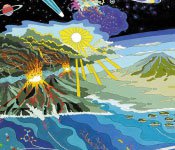
Many lines of evidence point to a rapid rise of atmospheric O2 between 2.45 – 2.22 billion years ago (Ga), a transition often referred to as the Great Oxidation Event (GOE). The cause of the GOE is unknown. It could have been an immediate consequence of the evolution of oxygenic photosynthesis. Alternatively, O2 biogenesis may be ancient and the GOE a consequence of an abiotic shift in the balance of oxidants and reductants at the Earth’s surface that crossed a critical threshold at that time. In the latter case, oxygenic photosynthesis could have evolved long before the GOE. This debate can be addressed by looking for evidence of localized or short-lived concentrations of O2 before 2.45 Ga.
We have found evidence of low levels of O2 in the late Archean Mt. McRae Shale, Western Australia. Samples were obtained from a drill core recovered as part of the Deep Time Drilling Project of the Astrobiology Drilling Program. Analyses at high stratigraphic resolution across ca. 100 meters of this core reveal an episode of enrichment of the redox sensitive transition metals Mo and Re, as well as correlated changes in S isotope systematics. Re-Os geochronology demonstrates that the enrichment is a primary sedimentary feature dating to 2501 ± 8 Ma. Mo and Re were probably supplied to Archean oceans by oxidative weathering of crustal sulfide minerals. The changes in S isotopes indicate onset of oxidative S cycling. Together, these findings point to the presence of small amounts of O2 in the environment > 50 Ma before the start of the Great Oxidation Event.
 A Talk With Jim Green
A Talk With Jim Green What Can Extant Genomes Reveal About Early DNA Metabolism?
What Can Extant Genomes Reveal About Early DNA Metabolism? What We Talk About When We Talk About Earth's Oxygenation
What We Talk About When We Talk About Earth's Oxygenation Bowling With Astrobiologists: A Twisted Path Toward the Origin of DNA
Bowling With Astrobiologists: A Twisted Path Toward the Origin of DNA